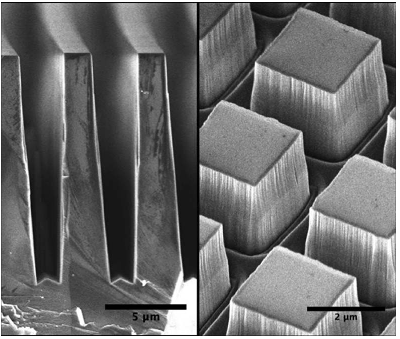




Did you find this useful? Give us your feedback













77 citations
77 citations
...We have recently shown (Delacroix et al. 2012b) that diamond is a good material for manufacturing achromatic half-wave plates for mid-infrared wavelengths (e.g., L and N bands centred respectively around 3.8 µm and 10 µm)....
[...]
...This process was painstakingly optimised to achieve the high pattern homogeneity, precision and aspect ratio necessary for half-wave plates and AGPMs in the N band (Delacroix et al. 2012a)....
[...]
71 citations
60 citations
55 citations
2,224 citations
...RCWA is an analysis method that is applicable to any multilayer grating profile [12,13]....
[...]
361 citations
...RCWA is an analysis method that is applicable to any multilayer grating profile [12,13]....
[...]
268 citations
...Another way of achieving broadband performance is stacking several crystal wave plates together [2] and orienting their birefringent axes using a Pancharatnam method [3]....
[...]
230 citations
200 citations
The diamond HWP shown in this paper has been developed to enable the manufacturing of an N-band annular groove phase mask ( AGPM ), which will be installed in 2012 on the VISIR instrument at the VLT, and is also an excellent candidate for METIS at the future European Extremely Large Telescope.
The phase retardation ΔΦ introduced by a birefrin-gent SWG between the two polarization components is dependent on the wavelength, and is given byΔΦTE–TM λ 2π λ Δnform λ ; (2)whereΔnform λ nTE λ − nTM λ : (3)h is the optical path through the birefringent medium.
By optimizing the gratings with manufacturing limitations in mind, components dedicated to the upper N-band (∼12 μm) could be achieved including an antireflective solution on their backside.
For the longest wavelengths (N-band mostly), the aspect ratio ρ is much lower for high refractive indices (>2.25), while for the shorter wavelengths, the filling factor F varies strongly, which results in a very fluctuating aspect ratio due to its definition as a minimum of either the wall or void thickness.
By varying the grating parameters (geometry, material, incidence), the wavelength dependence in Δnform should be tuned to be closely proportional to the wavelength across a wide spectral band.
the demand for instruments in the mid-infrared (L-band ∼3.8 μm, M-band ∼4.8 μm, N-band ∼10.5 μm) is increasing in many domains of astrophysics.
SWGs are micro-optical structures with a period Λ smaller than λ ∕ n, λ being the observed wavelength of the incident light and n the refractive index of the grating substrate.
The authors conclude that using substrates with high refractive indices (e.g., diamond,ZnSe, Ge) can make the microfabrication of SWGs for achromatic HWPs much easier.
Among the materials commonly used in the Nband, one good candidate is diamond, with a refractive index ∼2.38 for the region of interest (from 3 to 13 μm).
Another way of achieving broadband performance is stacking several crystal wave plates together [2] and orienting their birefringent axes using a Pancharatnam method [3].
Many new optical devices have been made with SWGs, such as high-efficiency diffraction gratings, polarization-selective gratings, wave plates, and monolithic antireflective structures [11].
a large spectral bandwidth is needed in many cases, especially in astrophysics, both to increase the signal-to-noise ratio and to allow spectrophotometry.
The diamond HWP shown in this paper has been developed to enable the manufacturing of an N-band annular groove phase mask (AGPM), which will be installed in 2012 on the VISIR instrument at the VLT, and is also an excellent candidate for METIS at the future European Extremely Large Telescope.
The larger periods and lower aspect ratios of the N-band HWP should make this grating easier to fabricate compared to bands of shorter wavelengths, as shown in Section 3.
In astrophysics, when it comes to observing a very high-contrast scene, one must be able to cancel the bright source, or at least drastically reduce its intensity.
This attenuation can be achieved by combining two portions of the incident light beam, one of which having to undergo a half wavelength (or π) phase shift.
A birefringent medium, such as a grating (see Fig. 1), has two different refractive indices, nTE and nTM, with regard to the polarization states TE (transverse electric, parallel to the grating grooves) and TM (transverse magnetic, orthogonal to the grating grooves).
In the first20 August 2012 / Vol. 51, No. 24 / APPLIED OPTICS 5899approximation, one can tell that the relation between the optimum line width and depth is quasi linear, with a regression coefficient approximately equal to 10.
The mean and standard deviation of the phase shift over the whole upper N-band (11–13.2 μm) equal ∼3.143 0.061 rad (180.08 3.51°).
A 2D SWG formed by binary square (2.6 × 2.6 × 2 μm) shaped structures with a 4 μm period was etched on the backside of the HWP to reduce the reflection from 17% to less than 0.5% in the wavelength region of interest (see Fig. 8).
The retardance of a zero-order wave plate varies hyperbolically with thewavelength, which limits the operation of single wave plates to monochromatic light.
After removing the effects of interference within the sample and comparing with an unetched sample, the transmittance of a single AR interface has been determined (Fig. 8).
The solution corresponds to the reflection and transmission matrices in the two modes (TE/TM), describing the entire diffractive characteristics of the simulated structure: the diffraction efficiencies (η m TE ) and (η m TM), and the phase shift (ΔΦTE–TM).